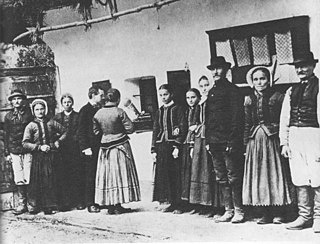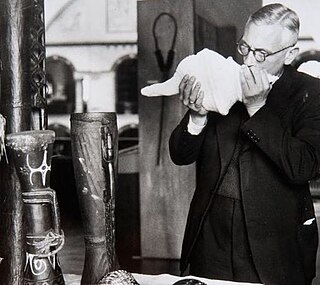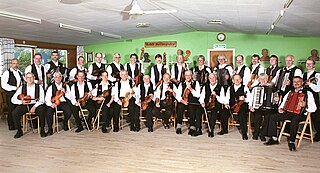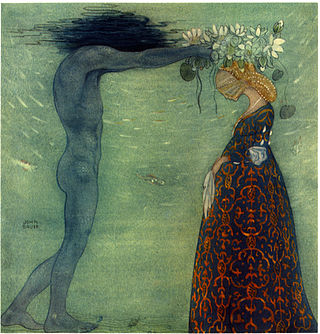Related Research Articles

Folk music is a music genre that includes traditional folk music and the contemporary genre that evolved from the former during the 20th-century folk revival. Some types of folk music may be called world music. Traditional folk music has been defined in several ways: as music transmitted orally, music with unknown composers, music that is played on traditional instruments, music about cultural or national identity, music that changes between generations, music associated with a people's folklore, or music performed by custom over a long period of time. It has been contrasted with commercial and classical styles. The term originated in the 19th century, but folk music extends beyond that.

Ethnomusicology is the multidisciplinary study of music in its cultural context, investigating social, cognitive, biological, comparative, and other dimensions involved other than sound. Ethnomusicologists study music as a reflection of culture and investigate the act of musicking through various immersive, observational, and analytical approaches drawn from other disciplines such as anthropology to understand a culture’s music. This discipline emerged from comparative musicology, initially focusing on non-Western music, but later expanded to embrace the study of any and all different kinds of music of the world.
A trow is a malignant or mischievous fairy or spirit in the folkloric traditions of the Orkney and Shetland islands. Trows may be regarded as monstrous giants at times, or quite the opposite, short-statured fairies dressed in grey.

The music of Greenland is a mixture of two primary strands, Inuit and Danish, mixed with influences from the United States and United Kingdom.
Georgia has rich and still vibrant traditional music, primarily known for arguably the earliest polyphonic tradition of the Christian world. Situated on the border of Europe and Asia, Georgia is also the home of a variety of urban singing styles with a mixture of native polyphony, Middle Eastern monophony and late European harmonic languages. Georgian performers are well represented in the world's leading opera troupes and concert stages.
Persian traditional music or Iranian traditional music, also known as Persian classical music or Iranian classical music, refers to the classical music of Iran. It consists of characteristics developed through the country's classical, medieval, and contemporary eras. It also influenced areas and regions that are considered part of Greater Iran.

Baris dance is a family of traditional war dances in Bali, Indonesia, accompanied by gamelan, in which dancers depict the feelings of a young warrior prior to battle, glorify the manhood of the triumphant Balinese warrior, and display the sublimity of his commanding presence. Baris derives its name from the word bebarisan, which literally means "line" or "file formation", referring to the soldiers who served the ancient rajas of Bali.

Assistens Cemetery in Copenhagen, Denmark, is the burial site of many Danish notables as well as an important greenspace in the Nørrebro district. Inaugurated in 1760, it was originally a burial site for the poor laid out to relieve the crowded graveyards inside the walled city, but during the Golden Age in the first half of the 19th century it became fashionable and many leading figures of the epoch, such as Hans Christian Andersen, Søren Kierkegaard, Christoffer Wilhelm Eckersberg, and Christen Købke are all buried here.
Tom (Tammy) Anderson MBE (1910–1991) was a Scottish fiddler, teacher, composer and collector of traditional tunes. He has been described as "...the most prominent personality in the entire history of Shetland fiddling."
James Oswald (1710–1769) was a Scottish composer, arranger, cellist, and music publisher, who was appointed as Chamber Composer for King George III and also wrote and published many Scottish folk tunes.
Willard Rhodes was an American ethnomusicologist. He is known for his extensive recording of American Indian music between 1939 and 1952.

Gerard Henri Luc Béhague was an eminent Franco-American ethnomusicologist and professor of Latin American music. His specialty was the music of Brazil and the Andean countries and the influence of West Africa on the music of the Caribbean and South America, especially candomblé music. His lifelong work earned him recognition as the leading scholar of Latin American ethnomusicology.
Moisei Iakovlevich Beregovsky was a Soviet Jewish folklorist and ethnomusicologist from Ukraine, who published mainly in Russian and Yiddish. He has been called the "foremost ethnomusicologist of Eastern European Jewry". His research and life's work included the collection, transcription and analysis of the melodies, texts and culture of Yiddish folk song, wordless melodies (nigunim), East European Jewish instrumental music for both dancing and listening, Purim plays, and exploration of the relationship between East European Jewish and Ukrainian traditional music.
Métis fiddle is the style that the Métis of Canada and Métis in the northern United States have developed to play the violin, solo and in folk ensembles. It is marked by the percussive use of the bow and percussive accompaniment. The Métis people are a poly-ethnic post-contact Indigenous peoples. Fiddles were "introduced in this area by Scottish and French-Canadian fur traders in the early 1800s", where the Metis community adopted the instrument into their culture.

Danish traditional music is the music genre that has its roots in pre-modern Denmark. In this period it was common for towns to have one or more town musicians who played at dances, processions and certain rituals. In the 17th and 18th centuries, professional music performances were monopolized by town musicians, who also traveled into the neighboring rural areas to perform. Urban music and dance styles, often from other parts of Europe, penetrated the countryside and almost eradicated earlier styles. This period also saw the introduction of the fiddle as the most important instrument and the abandonment of earlier chain dances in favor of pair dances. Until around 1900, traditional music was the common musical culture of Denmark, but with increasing urbanization and the spread of classical music it became marginalized to rural areas.

Danish folklore consists of folk tales, legends, songs, music, dancing, popular beliefs, myths and traditions communicated by the inhabitants of towns and villages across the country, often passed on from generation to generation by word of mouth. As in neighbouring countries, interest in folklore grew with an emerging feeling of national consciousness in 19th century Denmark. Researchers travelled across the country collecting innumerable folktales, songs and sayings while observing traditional dress in the various regions. Folklore today is part of the national heritage, represented in particular by national and local traditions, songs, folk dances and literature.

"Agnete og Havmanden" (Danish) or "Agneta och havsmannen" (Swedish) is a ballad. It is also found in Norway and as a prose folktale published by Just Mathias Thiele in his 1818 Danske Folkesagn, though Thomas Bredsdorff has argued that this prose version is of literary rather than folkloric origin. The ballad too is generally thought to be relatively late in its composition, perhaps from the eighteenth century.

Rasmus Nyerup was a Danish literary historian, philologist, folklorist and librarian.

Joan Rimmer was an English musicologist who specialised in the history of musical instruments and in historical dance forms. She was also a pioneer in ethnomusicology who presented, in the course of 30 years, numerous programmes on traditional music from around to the world on BBC radio.
Ethnomusicology is the study of music from the cultural and social aspects of the people who make it. It encompasses distinct theoretical and methodical approaches that emphasize cultural, social, material, cognitive, biological, and other dimensions or contexts of musical behavior, in addition to the sound component. While the traditional subject of musicology has been the history and literature of Western art music, ethnomusicology was developed as the study of all music as a human social and cultural phenomenon. Oskar Kolberg is regarded as one of the earliest European ethnomusicologists as he first began collecting Polish folk songs in 1839. Comparative musicology, the primary precursor to ethnomusicology, emerged in the late 19th century and early 20th century. The International Musical Society in Berlin in 1899 acted as one of the first centers for ethnomusicology. Comparative musicology and early ethnomusicology tended to focus on non-Western music, but in more recent years, the field has expanded to embrace the study of Western music from an ethnographic standpoint.
References
- ↑ Koudal, Jens Henrik . Rasmus Storms nodebog. En fynsk tjenestekarls dansemelodier o. 1760. København 1987; 2. edition 1997. ISBN 87-980636-7-7.
- ↑ "Music from the Notebooks of Rasmus Storm" (PDF). andyhornby.net.
- ↑ Koudal, Jens Henrik. 1993. Ethnomusicology and Folk Music Research in Denmark. Yearbook for Traditional Music Vol. 25, Musical Processes in Asia and Oceania, pp. 100-125
- ↑ Nielsen, Bent Christian. Review of Koudal 1987 "Rasmus Storm's nodebog" Ethnomusicology. Vol. 32, No. 3 (Autumn, 1988), pp. 482